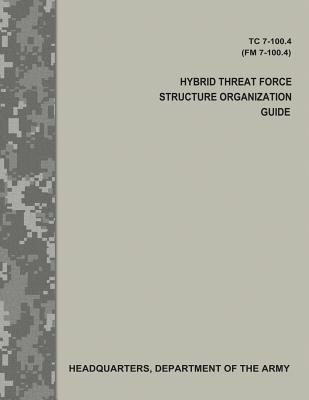
- We will send in 10–14 business days.
- Author: Department of the Army
- Publisher: CreateSpace Independent Publishing Platform
- ISBN-10: 197562761X
- ISBN-13: 9781975627614
- Format: 21.6 x 27.9 x 1.2 cm, minkšti viršeliai
- Language: English
- SAVE -10% with code: EXTRA
Hybrid Threat Force Structure Organization Guide (TC 7-100.4 / FM 7-100.4) (e-book) (used book) | bookbook.eu
Reviews
Description
This manual, TC 7-100.4, "Hybrid Threat Force Structure Organization Guide," is part of the 7-100 series, which describes the Hybrid Threat that exists for the purpose of training U.S. forces for potential combat operations. The Hybrid Threat reflects the characteristics of military and irregular forces that may be present in the operational environment (OE). Like those real-world threats, the Threat will continue to present new and different challenges for U.S. forces. The OE is constantly changing, and it is important for U.S. Army training environments to keep pace with real-world developments. This manual describes the Hybrid Threat Force Structure (HTFS) for training U.S. Army commanders, staffs, and units. It outlines a Hybrid Threat than can cover the entire spectrum of military and irregular capabilities against which the Army must train to ensure success in any future conflict. Applications for this series of TCs include field training, training simulations, and classroom instruction throughout the Army. All Army training venues should use a HTFS based on these TCs, except when mission rehearsal or contingency training requires maximum fidelity to a specific country-based threat or enemy. Even in the latter case, trainers should use appropriate parts of the Hybrid Threat TCs to fill information gaps in a manner consistent with what they do know about a specific threat or enemy.
EXTRA 10 % discount with code: EXTRA
The promotion ends in 21d.08:34:54
The discount code is valid when purchasing from 10 €. Discounts do not stack.
- Author: Department of the Army
- Publisher: CreateSpace Independent Publishing Platform
- ISBN-10: 197562761X
- ISBN-13: 9781975627614
- Format: 21.6 x 27.9 x 1.2 cm, minkšti viršeliai
- Language: English English
This manual, TC 7-100.4, "Hybrid Threat Force Structure Organization Guide," is part of the 7-100 series, which describes the Hybrid Threat that exists for the purpose of training U.S. forces for potential combat operations. The Hybrid Threat reflects the characteristics of military and irregular forces that may be present in the operational environment (OE). Like those real-world threats, the Threat will continue to present new and different challenges for U.S. forces. The OE is constantly changing, and it is important for U.S. Army training environments to keep pace with real-world developments. This manual describes the Hybrid Threat Force Structure (HTFS) for training U.S. Army commanders, staffs, and units. It outlines a Hybrid Threat than can cover the entire spectrum of military and irregular capabilities against which the Army must train to ensure success in any future conflict. Applications for this series of TCs include field training, training simulations, and classroom instruction throughout the Army. All Army training venues should use a HTFS based on these TCs, except when mission rehearsal or contingency training requires maximum fidelity to a specific country-based threat or enemy. Even in the latter case, trainers should use appropriate parts of the Hybrid Threat TCs to fill information gaps in a manner consistent with what they do know about a specific threat or enemy.


Reviews